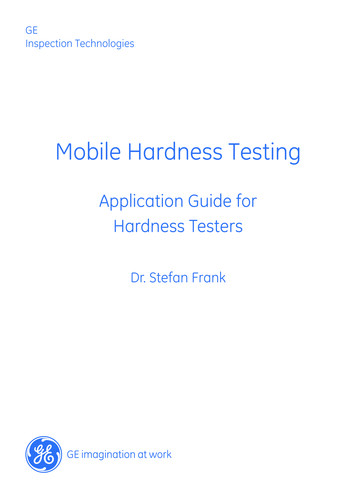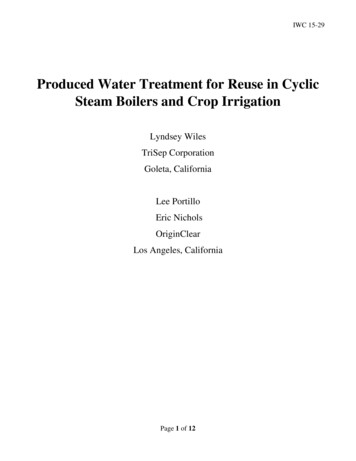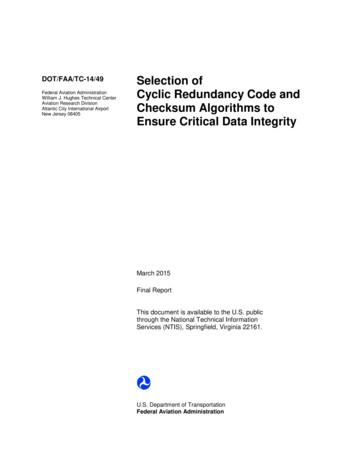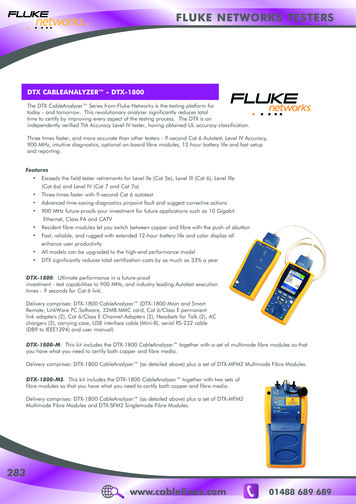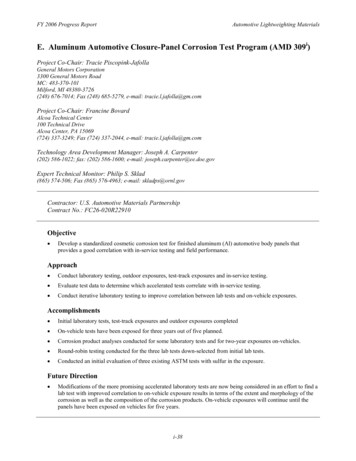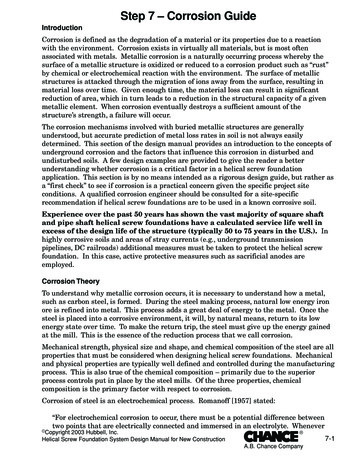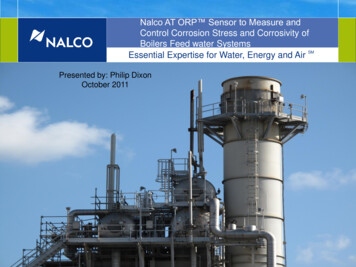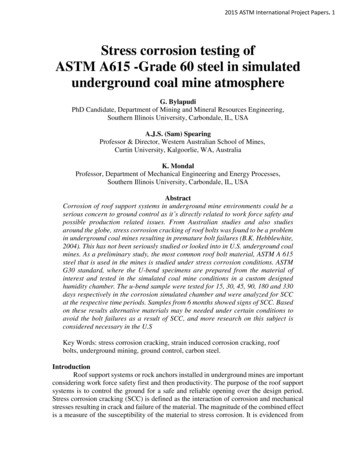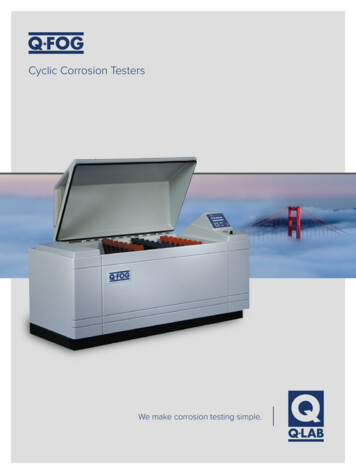
Transcription
Cyclic Corrosion TestersWe make corrosion testing simple.
Corrosion BasicsWhy Q-FOG?Simple to AffordSimple to UseSimple to MaintainQ-FOG corrosion testers were specifical-Q-FOG cyclic corrosion testers are easyWe believe that just because a productly designed to have the lowest total costto install, easy to program, and easy tois technical, it doesn’t have to be hard toof ownership in the industry.Their lowoperate. Specimen mounting and evalua-understand or difficult to maintain and repair.purchase price, high reliability, and lowtions are simplified with a low belt line andInstead of complicating our tester designsoperating costs set a new standard for cor-easy-opening lid. All models are complete-by loading them with extra or unnecessaryrosion testers. And the new model CRHly automated and can operate continuously,features, we put our engineering effort intorepresents a breakthrough in price-per-24 hours per day, 7 days per week, withoutkeeping things simple.formanceCorrosion causes billions of dollars in productand infrastructure damage every year.Itdegrades the useful properties of materials,especially metals. This can include loss ofstrength, appearance, and permeability to liquidsand gases. In just a few days or weeks, a Q-FOGtester can reproduce the damage that occursSubsystems arecorrosionsupervision. The testers are smart enoughmodular, easy to troubleshoot and easy tochambers. Now even the smallest lab canto alert you to issues they may encounterreplace. This makes typical maintenanceafford cyclic corrosion testing.during testing.and repair of Q-FOG testers simple enoughforRH-controlledthat it doesn’t require a field technician (butover months or years outdoors.we’re here if you need us).Cyclic Corrosion TestersCyclic corrosion testing provides the bestIn a Q-FOG cyclic corrosion tester, speci-grammed with the easy-to-operate Q-FOGpossible laboratory simulation of naturalmens are exposed to a series of differentcontroller.corrosion. Current research indicates thatenvironments in a repetitive cycle thatcyclic corrosion testing results are similar tomimics outdoors. Simple cycles, such asQ-FOG chambers are available in threeoutdoors in resulting structure, morphology,Prohesion, may consist of cycling betweentypes. The base model SSP performs tradi-and relative corrosion rates. Prior to cyclicsalt fog and dry conditions. More sophis-tional salt spray and Prohesion tests. Modeltesting, conventional salt spray (a continu-ticated automotive methods may call forCCT performs salt spray, Prohesion, andous salt spray at 35 C) was the standard waymulti-step cycles that incorporate humidity,most cyclic automotive tests. Model CRHto simulate corrosion in a lab. Because con-along with salt spray and dry-off.adds variable relative humidity control andan optional shower function. All Q-FOGventional salt spray methods failed to mimicthe natural wet/dry cycles of outdoors, testWithin one Q-FOG chamber, it is possiblechambers are available in two sizes to fulfillresults frequently provided poor correlationto cycle through all of the most significanta range of testing requirements.to outdoors.corrosion environments.Even the mostcomplex test cycles can easily be pro-Every feature of a Q-FOG tester was designed with simplicity and reliability in mind.2www.q-lab.comwww.q-lab.com3
Q-FOG ModelsQ-FOG SSPQ-FOG CCTQ-FOG CRHNumerous accelerated corrosion testsThe Q-FOG model CCT has all the advan-The Q-FOG model CRH represents a true breakthrough in the price-performance ratio of corrosionmay be performed in the Q-FOG basetages of the model SSP, but adds thetesters with RH control. It has all the advantages of the model CCT, but adds full variable humiditymodel SSP, including Prohesion, ASTMflexibility of including 100% humidity. This iscontrol through the use of an innovative air pre-conditioner. It is compatible with most major auto-B117, ASTM G85, BS 3900, F4 & F9, DINanother critical exposure condition to manymotive corrosion test standards, such as GMW 14872, SAE J2334 and others from Ford, ISO, GB/T,50.021, ISO 9227, GB/T 10125 and manycyclic corrosion tests. CCT units comeVW, Volvo, Chrysler, Renault, etc. Additionally, this model includes an optional programmable showerothers. The SSP chamber is our mostequipped with a viewing window in thefunction with an advanced cleaning feature for spray nozzles that prevents clogging frequently foundeconomical model, and can perform saltside of the lid and an internal light to allowin competitive chambers. The available Rapid Ramp Heater capability allows the Q-FOG CRH to meetfog, dwell and dry-off functions.easy monitoring of test conditions.fast temperature and transitions, like those called for in standards such as JASO M609, CCT-I, CCT-II,for Prohesion or ConventionalSalt Sprayfor Research and Cyclic Automotive Testswith 100% Humidityfor Research and Cyclic Automotive Testswith Variable Relative Humidity Controland CCT-IV, even when the chamber is fully loaded with specimens.4www.q-lab.comwww.q-lab.com5
3Key Features1Two ConvenientSizes for Each Model2Easy SampleMounting3Reinforced FiberglassConstructionAll Q-FOG models (SSP, CCT, andThe Q-FOG chamber has a low beltQ-FOG testers are made of solid,CRH) are available in two convenientline and an easy-opening lid for easierfiber-reinforced plastic.chamber sizes (600 and 1100 liters) toaccess during sample mounting. Testheavy-walled chamber and lid have lowaccommodate small and large speci-panel racks, hanging rod kits, and flatthermal conductivity for efficient, pre-men quantities.Caster wheel kits aregrates are available to convenient-cise temperature control. Heat resistantavailable to allow for easy repositioningly mount specimens of all shapes,plastics allow testing at higher tempera-of the tester in laboratories with tightsizes, and weights up to a maximum oftures than competitive cabinets.space requirements.544 kg (1200 pounds).4Internal SolutionReservoir5Remarkably SimpleUser Interface5The robust,41Rapid ChamberTemperature CyclingSpace utilization is maximized and main-The Q-FOG tester’s user interface isQ-FOG testers can change tempera-tenance is minimized with the Q-FOGdesigned to be functional, highly reli-tures exceptionally fast because of theirmachine’s internal solution reservoir.able, and easy to use. The controllerunique internal chamber heater andThe clearly-marked 120 liter reservoirallows for complete self-diagnosticcooling/dry-off blower. An additionalhas enough capacity for running mosterror checking and can be programmedair heater allows very low humidity dry-tests for 7 days or more. The reservoirin 5 user-selectable languages (English,off exposures. The Q-FOG CRH Rapidhas an integral salt filter and a built-inGerman, Spanish, French, and Italian).Ramp Heater option further enablesalarm to alert the operator when thevery fast temperature and humidity con-solution is low.dition changes. See page 102Relative Humidity ControlThe Q-FOG model CRH features precisePrecise Control of FogDispersionEasy Operation &MaintenanceShower Module with SelfCleaning Nozzlescontrol of relative humidity through theuse of an air preconditioner (see right),for compatibility with most major automotive cyclic corrosion standards. ThisThe Q-FOG tester has superior fogAll components in a Q-FOG tester areThe Q-FOG model CRH adds an option-dispersion compared to convention-positioned to allow easy access foral shower module for uniform sprayal systems which cannot vary volumecalibration, inspection, and routine pre-throughout the chamber, in accordanceand distance independently. A variableventive maintenance. Sub-systems arewith many automotive test standards.speed peristaltic pump controls themodular for easy repair. The Q-FOGQuick-disconnect spray nozzles haveamount of corrosive solution deliveredcontroller features complete self-diag-an innovative self-cleaning feature toto the spray atomizer, while the air pres-nostics, including descriptive warningprevent precipitate clogging, oftensure regulator controls the distance ofmessages and automatic safety shut-found in competitive test chambers.the “throw.” See page 10down. See pages 12-13See page 116www.q-lab.cominnovation compensates for most laboratory temperature and RH variations.More on page 11Q-FOG testers aren’t loaded with unnecessary features — just the ones you need.www.q-lab.com7
Corrosion Testing & StandardsCyclic Corrosion TestsCyclic corrosion tests expose specimens toa series of different environments in a repeti-A more serious limitation of tests such as ASTM B117 is that they provide a continuousenvironment with no changes in conditions. In contrast, materials exposed to the weath-tive cycle. Simple tests may consist of cyclinger experience cyclical changes in wetness, temperature, sunlight, and corrosive solutionbetween two conditions: fog and dry. Moreconcentration. Corrosion in a cycling environment can be very different from corrosion insophisticatedwill best resist corrosion.procedures(especiallya continuous cycle, in terms of both the chemical reactions and the type of materials thatforautomotive testing) call for multi-step cyclesAs such, many automotive corrosion test methods typically call for exposing specimens toa repetitive cycle of salt spray, high humidity, low humidity dry-off, and ambient conditions.incorporating humidity, along with salt fog orThese test methods were originally developed as labor-intensive manual procedures.More recent cyclic automotive test methods, such as GMW 14872, incorporate controlledshower functions, and dry-off.relative humidity conditions, which are often challenging to obtain in many lab conditions.These test methods sometimes call for a shower/rain step with higher flow than typicalfine-mist salt fog. Ramp times are also often tightly controlled.Prohesion and Conventional Salt SprayCyclic Corrosion Tests with UV ExposureNumerous accelerated corrosion tests may be performed in Q-FOG model SSP, includingThe QUV accelerated weathering tester and Q-FOG cyclic corro-Prohesion, ASTM B117, ASTM G85, BS 3900 F4 and F9, DIN 50.021, ISO 9227, and GB/Tsion testers have outstanding advantages on their own. But when10125, just to name a few.used together, they are revolutionizing corrosion testing, particularlyfor industrial maintenance paints on bridges and other infrastructureProhesion.This test uses one-hour fog and one-hour dry-off, rapid tempera-applications.ture changes, and a different corrosive solution to provide a more realistic test.Many researchers have found this test useful for industrial maintenance coatings.Ultraviolet light stability of a coating can be a major factor in its corrosion resistance. Research indicates that a test cycle alternatingConventional Salt Spray. Continuous salt spray exposures are widely specified for testingbetween a QUV accelerated weathering tester and a Q-FOG cycliccomponents and coatings for corrosion resistance. Applications include: plated and paint-corrosion tester can give more realistic results than corrosion testinged finishes, aerospace and military components, and electrical and electronic systems.alone. See ASTM D5894 for more information.Most of these tests are performed to particular specifications such as ASTM B117 (SaltSpray), and BS 3900 F4. These tests are widely used for quality control and validationtesting. They are typically run at an elevated temperature and do not incorporate a dry-offcycle. They require heated, humidified air for the spray.8www.q-lab.comAlternating QUV exposure and Q-FOG cyclic corrosiontesting can improve correlation for some materials.www.q-lab.com9
Cyclic Corrosion TestersHumid Function (Model CCT Only)During the Humid Function in CCT models, the chamberHow They WorkD.I.Water Inis maintained at 95-100% relative humidity by forcing hotVaporGeneratorwater vapor into the chamber. Deionized water is requiredfor proper operation. The vapor generator heater maintainsthe programmed chamber temperature.Fog Function (All Models)Q-FOG model CRH testers utilize the RH Function in placeof the Humid Function.tester typically operates as a conventionalsalt spray unit: VentLidDuring the Fog Function, the corrosionControllerSpecimensSolutionReservoirThe Shower Function is used for some automotive test specifica-Corrosive solution from the internalreservoir is pumped to the nozzle Compressed air is humidified bypassing through the bubble tower onits way to the nozzle VentLidSolutionReservoirChamberHeatertions. A user-adjustable volume of solution is uniformly sprayedBubbleTowerSpecimens FogCompressedAir InControllerNozzle fine, corrosive fog mistBubbleTowerChamberHeaterFogNozzleNozzles are mounted to a spray bar, which can beShower ModuleAssemblySpray droplets are much bigger, flow rates are muchhigher, and shower times are much shorter than thePumpChamber heaters maintain the programmed chamber temperatureonto specimens through specially positioned nozzles:easily removed when using the Fog FunctionNozzle atomizes solution air into a Shower Function (Optional for Model CRH Only)SolutionTo PumpCompressedAir InShowerPumpatomized solution mist in the Fog Function Shower on/off times can be directly programmed toallow for excellent control of corrosion ratesRH Function (Model CRH Only)PumpDry-Off & Dwell Functions (Models SSP & CCT)DiffuserIn CRH models, the chamber can ramp to and maintain a defined RH value and temperature through the use of the air preconditioner,SolutionTo Pumpthe blower module, and special atomizing humidification nozzles. DI water is required for proper operation. Optional Q-FOG RapidAir HeaterDuring the Dry-off Function, a purgeRamp Heaters (shown below) can meet very challenging temperature and ramp times. Also, see operating manual for details on RH/blower forces room air over an air heater,through diffusers, and across specimenstemperature capabilities vs. laboratory condition requirements.Blowerin the chamber. This creates a low humidity condition
Prohesion, ASTM B117, ASTM G85, BS 3900 F4 and F9, DIN 50.021, ISO 9227, and GB/T 10125, just to name a few. Prohesion. This test uses one-hour fog and one-hour dry-off, rapid tempera-ture changes, and a different corrosive solution to provide a more realistic test. Many researchers have found this test useful for industrial maintenance coatings. Conventional Salt Spray. Continuous salt spray .
